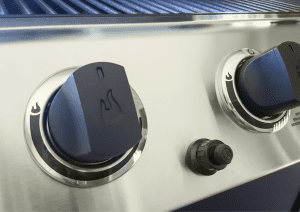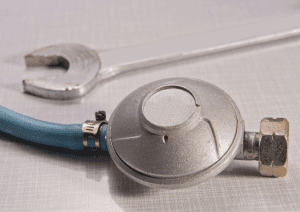Do you want to know how to reset the gas grill regulator? It can be because you turned the grill on to warm it up, hoping that the grill will be ready to cook by the time everyone arrives. Then you realized that the flame is weak, and the grill temperature only goes up to 250 or 300 degrees Fahrenheit. Started to panic? Read this to know the proper way to rest the gas grill regulator before calling your BBQ Grill Repair Company.
Before we dive headfirst into the solution, let’s take a look at …
What you’ll learn about How to Reset a Gas Grill Regulator
Why here? You’re right to think about why we have added a summary at the beginning of the article. The reason is, a glance will help you know that you’re at the right place to learn about regretting the propane regulators.
A gas grill regulator is a small device that is screwed onto an LPG or propane tank. It regulates the gas flow from the gas tank. It also includes a safety mechanism known as a bypass. The gas regulator consists of a ball and spring and automatically cuts off the gas supply when the hose is devoid of the back pressure.
Generally, it happens when there’s a leak. It can also be activated if the gas tank and one of the burners are turned on. You should turn off the gas tank and wait for a while before turning on the burners.
What is a Gas Grill Regulator?

The grill regulators (or propane gas regulators) are a component of the gas grills that controls the gas flow from the fuel canister to the heating element. It also acts as a safety barrier between the high-pressure propane tank and the heating appliance.
In short, it brings the pressure of the propane down to a safe level. If the pressure is too low, the grill may not heat up. If it is too high, it may cause a flameout (or worse).
How does a Gas Grill Regulator Work?
The regulator is bound to a propane tank to manage the gas flow to the burner of your grill. The higher the gas flow, the larger the flame, and thus the more heat. If the gas flow is low, the flame will be small, and the amount of heat will be low.
In addition, the regulator has what is called a bypass, which is a plastic mechanism that cuts off the gas supply when there is no pressure in the hose extending from the grill. This can be caused by a gas leak or by leaving the burners on for a long time.
What is Bypass Mode?
All BBQ gas grills have a regulator, which, as the name implies, regulates the flow of propane gas. The regulator has a built-in safety mechanism called a bypass valve. This bypass valve system sits between the regulator and the propane tank.
Usually, the system is in a locked state. This is the activated or tripped state of the safety mechanism. In some cases, this is caused by gas leakage, but in most cases, it is due to the user using an improper ignition method.
The safety device of gas regulators consists of a ball and a spring. The pressure from the propane tank pushes the ball against the spring. When it happens, a gas flow is established. If there’s a leakage or burners are left open, the reverse flow of the air pressure doesn’t let the ball displace from its position inside the regulator. As a result, propane from the LPG canister can’t pass through the safety device.
If you don’t light the grill in a certain way, the safety device will mistake it for a leak and reduce gas flow from the canister to less than 10% of normal. This condition is called “bypass.” When the gas supply is reduced, the grill cannot be brought up to its normal temperature, and in some cases, the grill will not light.
If you find yourself in a bypass situation, please check for leaks first (that’s what the safety device is for).
What’s the Proper Ignition Sequence for Gas Grill?

Following the proper ignition sequence for your gas grill is important to prevent your grill from entering bypass mode.
If you do not find any gas leaks, you can follow the steps below to get out of the bypass and not enter the bypass in the future.
The way to prevent yourself from entering the bypass is very simple.
-
Open the lid of the grill.
Ensure the grill lid is open and all control knobs are turned off (side burner knobs included, if any).
-
Open the Tank Valve
Open the tank valve at the top of the propane tank to connect the gas supply.
-
Wait for sometime
Wait a few seconds for the hose to build up pressure before doing anything else. This pressure will push the equipment in and give you the “all clear” to operate normally. It should be noted that allowing the pressure to build up is the most significant part of the entire process.
-
Turn on the Burner and Push the Ignition Button
After a short wait, turn the appropriate burner to start/high and press the igniter button to ignite, just as you would with a normal grill. The actual ignition method will vary depending on your particular model. Please refer to your owner’s manual for details.
Light all main burners, turn the temperature to high and close the lid. After about 10-15 minutes, if the temperature reaches 500-550℃, the liquid propane grill is working properly.
Basically, the key is to always turn off the burner before you turn on the liquid propane tank valve. If you turn on the burner first, the gas won’t be pressurized in the gas line, and the bypass will be activated.
To the system, it looks like there is a leak, so the bypass is activated or triggered. (Even if there is no gas leak, the system will think there is a leak because of the low back pressure.)
Side note: If used in the wrong order, the regulator will trip. Turning the burner on first will empty the propane line, resulting in low line pressure.
How do I Know if My Grill has a Faulty Propane Tank Regulator?
Possible indications of a faulty regulator or appliance include:
- A lingering yellow or orange flame
- A popping sound when the grill burners are turned off or on
- Floats of flame above the burner port
- A roaring sound from the burner,
- Flames appearing at the burner intake
- Flame overflow from the burner or a large amount of soot.
In most cases, performing a propane regulator reset will get the job done for you. However, sometimes, especially if there’s a severe issue with the propane regulator, resetting the regulator isn’t the option, and you’ll have to replace it.
When Should I Perform a Regulator Reset?
You need to reset the regulator if:
1. The burner does not light up
Despite making all efforts, the gas grill fails to ignite: whether through electric ignition or manual, the problem can be with the regulator.
2. The grill is not hot enough.
It’s not necessary the failure to ignition can indicate that you need to reset the regulator. In fact, low temperatures can also be the reason for propane regulators in need of a reset.
3. The disturbed flames’ pattern
If you see that the flame of your gas grill is of bright yellow or orange color or not even, it can hint at the regulator reset.
Also, please note that the flame should always be blue. If it’s not and you’re constantly getting the yellow flame, it’s problematic, and you can go ahead and either clean your burner tubes or reset the gas regulator.
How do You Test the Gas Regulators?
If the gas regulators continuously trip, there may be a leak in the hose. Close the valve on the gas tank and disconnect the regulator and gas line from the propane tank. Immerse the regulator in a solution of soap and water, then attach the regulator and hose back to the gas container.
Make sure the burners on the grill are “off,” and the valve on the tank is turned on. Soap bubbles will indicate the location of any leakage in the regulator or hoses. Replace the regulator or hose as necessary.
How to Reset Your Propane Regulators?
Now that we know what the problem is with the propane regulator, let’s try to come up with a solution. Of course, this assumes that you have checked your gas container to see if it simply needs to be replaced with a new propane tank.
This is the complete step-by-step process for how to reset the gas grill regulator.
- Cut off the supply from the fuel container.
- Turn the shutoff valve on the propane tank to the OFF position by rotating the valve clockwise until it is fully closed.
- Disconnect the hose from the gas tank.
- Lift the barbecue grill lid to make sure there is no gas buildup.
- Make sure all burners are on “high.”
- Wait for 2 minutes and don’t do anything.
- Switch off all burner valves.
- Now reconnect the hose to the fuel container.
- Slowly turn on the supply from the fuel container by rotating the valve counterclockwise. Make sure you do it very slowly to avoid tripping the regulator. It should take 20-30 seconds.
- Ignite the grill to resume its normal operation.
Final Thoughts
When it’s about cooking on your grill, a tip-top gas regulator can guarantee the constant flow of heat for your BBQ and save you from distress. The regulator reset call, however, needs the right identification of the problem first. It might be your grill regulator demands to be replaced, and working on the valves can be of no help. You can take the right steps by following this quick guide. Hence, if your grills fail to serve your outdoor cooking with sufficient temperature, follow this expert guide on how to reset the gas grill regulator.
universitygrill.net is a participant in the Amazon Associate program and will earn from qualifying purchases.

